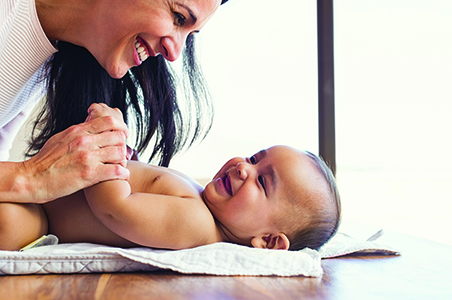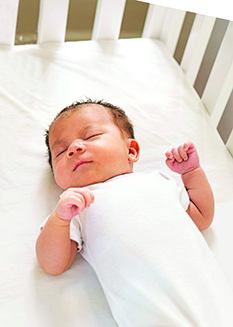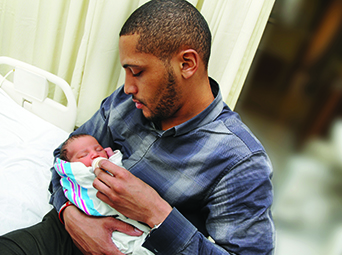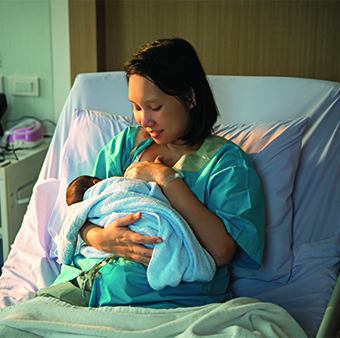At Stony Brook Children’s Hospital, the only children’s hospital and the only verified Level I trauma center for children in Suffolk County, we are committed to keeping all the children in our community safe. We’ve prepared these tips to help parents and caregivers of infants know some of the best practices for protecting them from harm.
Sleep Safety for Babies
Car Seat Safety for Babies
Soothing Your Baby
Feeding Your Baby
Keep Them Low, Don’t Let Go

In our hospital and trauma center, we consistently find the leading cause of injury related to hospitalization in babies is falls, most commonly resulting in traumatic brain injury. Following just a few simple suggestions can help protect your baby.
- When your child is in a carrier or baby seat, keep it on the floor
- Never place a baby seat or a baby carrier on any elevated surface (e.g., table, chair or bed) no matter what the age of your baby. Even newborn infants can move, which means they can fall
- Keep a hand on your baby whenever he or she is on a changing table or any raised surface
- Hold your baby with a tight grip whenever he or she is in your arms. Be prepared for sudden jerks
- Whenever your baby is in a car seat, a high chair, a supermarket cart, a swing or a carrier, be sure your baby is strapped in securely
Feel free to print this sheet out about Fall Prevention, and share it with others who may be caring for your infant, or who have infants.
Find out more from our expert here.
Learn the ABCs of Infant Safe Sleep —
Alone. Back. Crib. Every baby, every sleep!
 Follow these tips and the ABCs of infant safe sleep:
Follow these tips and the ABCs of infant safe sleep:
- Room sharing with parents is great. But you should never sleep in a bed with your baby
- Never place babies to sleep on adult beds, chairs, sofas, waterbeds, pillows, cushions or soft surfaces
- Dress your baby in sleep clothing, such as a sleep sack, and do not use a blanket
- Avoid letting the baby get too hot. Keep room temperatures in a range comfortable for a lightly clothed adult (68 to 72 degrees)
- Infants should receive all recommended vaccinations
- Breastfeeding is recommended to help to reduce the risk of SIDS
- Consider using a pacifier at nap time and bedtime, once breastfeeding is well established
- Avoid smoke exposure during pregnancy and after birth. Place the crib in an area that is always smoke free
- Supervised, awake tummy time is recommended daily to facilitate development
- Make sure everyone who cares for your baby, including child care providers, family and friends, knows about the importance of placing your baby to sleep on his/her back for every sleep
- Obtain regular prenatal care to reduce the risk of SIDS even before birth
- Avoid alcohol and illicit drug use during pregnancy and after birth
Feel free to print this sheet out about the ABCs of Infant Safe Sleep, and share it with others who may be caring for your infant, or who have infants.
- Babies should ride in a safety-approved car seat facing the rear of the car for the first two years of life
- Car seats should be installed in the back seat
- Harness straps should be snug against your child
- Avoid putting bulky clothing on your child when placing him/her in the car seat. Even in cold weather, dress your baby in lightweight clothing, buckle the harness securely, and use a blanket tucked around your child for warmth
- Place the harness retainer clip at armpit level
- Purchase a car seat that fits your child, vehicle and budget
- NEVER leave your child alone in a car, not even for a minute
- Be sure to read the vehicle owner’s manual AND the car seat instructions for proper installation instructions
- If you need help installing your car seat, or want it installed by a safety expert, you can find a fitting/inspection station at http://www.safeny.ny.gov/seat-per.htm
For more information about car seat safety, call (631) 444-3783.
Understanding that it’s often normal for babies to cry and how to properly soothe your baby can help keep you from getting anxious and upset yourself.

- Babies cry for a lot of reasons: hunger, pain, tired, clothes too tight, dirty diapers, too hot, too cold
- Call your healthcare provider if your baby acts sick or appears to be in pain
- If your baby does have an illness or a disease, it is important to take whatever measures are appropriate for that condition in order to treat it
- However, often crying is NOT due to sickness, illness or disease, but is part of the normal early behavioral development of your baby
- There is a normal increase in crying that occurs in the first months of your baby’s life. When this happens ask yourself the following questions:
- Why is my baby crying?
- What can I do to calm my baby?
The five S’s to Soothing a fussy baby.
The Dr. Harvey Karp method: Swaddle, Side or Stomach position, Shush, Swing and Suck.
Swaddle
Swaddle your crying or fussy baby snugly, with arms at the sides, using a thin blanket.
Side or Stomach
Once swaddled, position your baby on its side or stomach when it’s in your arms or on your lap. NEVER put your baby to sleep on its side or stomach.
Shush
A shush sound can calm and comfort your baby, help stop crying and fussing, and help your baby go to sleep and stay asleep. Newborns don't need silence. In fact, they're happier and better able to calm down and sleep in a noisy environment.
Loudly say and repeat "shhh" into your swaddled baby's ear as you hold him or her on side or tummy.
Put your lips right next to your baby's ear and "shhh" while also gently jiggling the baby. Shush as loudly as your baby is crying. As the baby calms down, lower the volume of your shushing to match.
Swing
Do not swing your baby in a baby swing. Instead gently jiggle your swaddled baby using very small, rapid movements in your arms.
While shushing your swaddled baby in a side or stomach position, support your baby’s head and gently jiggle – DO NOT SHAKE!
Move back and forth no more than an inch in any direction.
Suck
Give the baby a pacifier or thumb to suck on. Pacifiers reduce the risk of SIDS, so it's okay to let your baby keep the pacifier in bed.
Every baby is different, so experiment and see what works for your child.
PURPLE Crying
Sometimes when babies cry they can’t be soothed. If your baby is fed, has a clean diaper, isn’t too hot or too cold or in pain, and can’t be soothed, your baby may be going through a period of PURPLE crying.
The Letters in PURPLE stand for:
P - Peak
Your baby may cry more each week, the most in month 2, then less in months 3 to 5
U - Unexpected
Crying can come and go and you don’t know why
R – Resists soothing
Your baby may not stop crying, no matter what you try
P – Pain-like face
A crying baby may look like they’re in pain, even when they are not
L – Long Lasting
Crying can last up to five hours a day, or more
E – Evening
Your baby may cry more in the late afternoon or evening
For more information visit:
https://happiestbaby.com/using-the-5-ss/
https://dontshake.org/purple-crying/a>

Breast milk is best for baby because it offers these benefits:
- Easier for your baby to digest
- Doesn't need to be prepared
- Always available
- Contains all the nutrients, calories, and fluids your baby needs
- Contains growth factors that ensure optimal development of organs
- Has substances that formulas don't have that protect your baby from many diseases and infections
Breastfed babies are less likely to develop:
- Ear infections
- Diarrhea
- Pneumonia
- Wheezing
- Bronchiolitis and other bacterial and viral infections, such as meningitis
Breastfeeding may help to protect babies from:
- Obesity
- Diabetes
- Sudden Infant Death Syndrome (SIDS)
- Asthma
- Eczema
- Colitis
- Certain cancers
Breastfeeding also benefits the mother
- Releases hormones in your body that promote mothering behavior
- Returns your uterus to the size it was before pregnancy quicker
- Burns more calories, which may help you lose the weight
- Reduces the risk of ovarian cancer and breast cancer
- Keep bones strong, which helps protect against bone fractures in older age
Important to know:
- Formula is an acceptable alternative to breast milk
- Feed your baby ONLY breast milk or formula
- Feed every 2-3 hours day and night
- Never heat milk or formula in a microwave
- Store milk or formula as directed
For more information, call (631) 444-3783.
Feel free to print this Breastfeeding Log out to help you keep track of the number of times you pump and the volume of milk you produce. Feel free to also share it with others who have infants.

